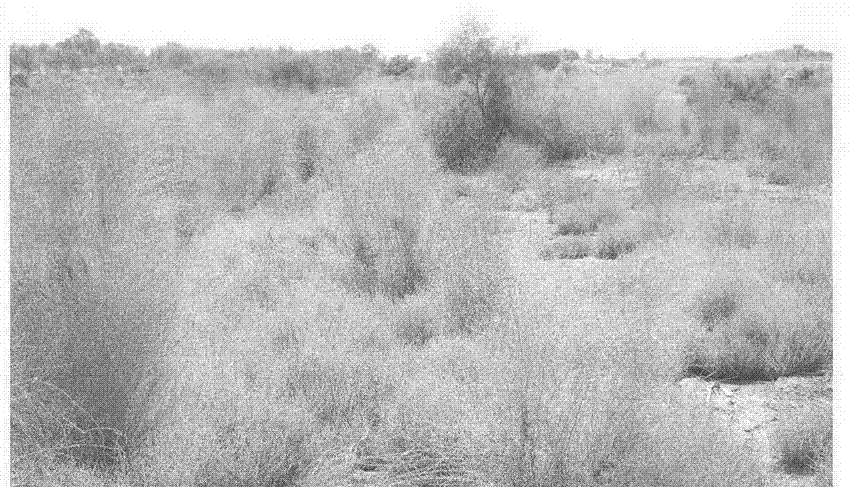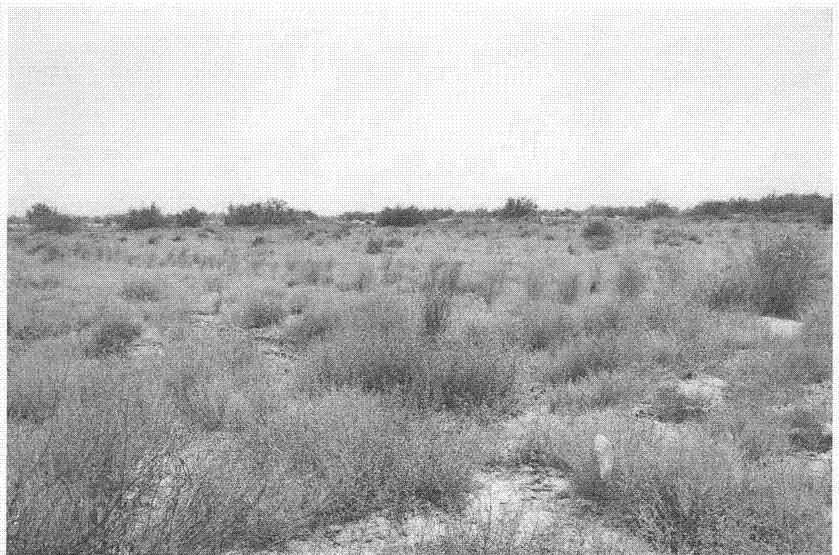Species assembly method for rapidly improving vegetation coverage degree of extreme arid region
A technology of vegetation coverage and assembly method, which is applied in the field of species assembly to rapidly increase vegetation coverage in extreme arid desert areas, can solve problems such as low survival rate of poor soil plants, land desertification, and secondary salinization difficult to improve, and achieve Reduce soil desertification, fix soil salinity and fertilize, and ensure normal germination
- Summary
- Abstract
- Description
- Claims
- Application Information
AI Technical Summary
Problems solved by technology
Method used
Image
Examples
Embodiment 1
[0023] a. Soil preparation: Select desertified land with an average electrical conductivity of 8.01ms / cm and an average water content of 5.15g / L from the soil surface to the depth of 50cm in the Yingsu section of the lower reaches of the Tarim River. The depth is 20cm to plow and dry for 3 days, and then dig a 30cm×30cm soil pit with a plant row spacing of 50cm for subsequent use;
[0024]b. Plant species configuration mode: select local dominant plants through conventional soil seed bank germination tests and regional surviving plant species surveys and classify them into arbor, shrub and grass, and select four types of plants from them: developed root system, drought resistance, and salt-alkali tolerance The dominant tree is Populus euphratica, the deep-rooted, drought-resistant, salt-secreting shrubs Tamarix and Haloxylon, drought-tolerant and salt-resistant, perennial deep-rooted herbs camel thorn and apocynum, salt-alkali-resistant, wide habitat, easy to germinate, and eas...
Embodiment 2
[0029] a. Soil preparation: select sandy soil with an average conductivity of 1.13ms / cm and an average water content of 4.77% from the soil surface to a depth of 50cm, and plow the soil surface to a depth of 20cm from September to October , aired for 4 days, then dig a 30cm×30cm soil pit with a distance of 50cm between plants and rows, and set aside;
[0030] b. Plant species configuration mode: select local dominant plants through conventional soil seed bank germination tests and regional surviving plant species surveys and classify them into arbor, shrub and grass, and select four types of plants from them: developed root system, drought resistance, and salt-alkali tolerance The dominant tree is Populus euphratica, the deep-rooted, drought-resistant, salt-secreting shrubs Tamarix and Haloxylon, drought-tolerant and salt-resistant, perennial deep-rooted herbs camel thorn and apocynum, salt-alkali-resistant, wide habitat, easy to germinate, and easy to survive , Shallow-rooted...
Embodiment 3
[0035] a. Soil preparation: choose sandy soil with an average conductivity of 11.16ms / cm and an average water content of 12.89% from the soil surface to a depth of 50cm, and plow the soil surface to a depth of 20cm from September to October , dried in the sun for 5 days, and then dug a 30cm×30cm soil pit at a distance of 50cm between plants and rows, and set aside;
[0036] b. Plant species configuration mode: select local dominant plants through conventional soil seed bank germination tests and regional surviving plant species surveys and classify them into arbor, shrub and grass, and select four types of plants from them: developed root system, drought resistance, and salt-alkali tolerance The dominant tree is Populus euphratica, the deep-rooted, drought-resistant, salt-secreting shrubs Tamarix and Haloxylon, drought-tolerant and salt-resistant, perennial deep-rooted herbs camel thorn and apocynum, salt-alkali-resistant, wide habitat, easy to germinate, and easy to survive ,...
PUM
 Login to View More
Login to View More Abstract
Description
Claims
Application Information
 Login to View More
Login to View More - R&D
- Intellectual Property
- Life Sciences
- Materials
- Tech Scout
- Unparalleled Data Quality
- Higher Quality Content
- 60% Fewer Hallucinations
Browse by: Latest US Patents, China's latest patents, Technical Efficacy Thesaurus, Application Domain, Technology Topic, Popular Technical Reports.
© 2025 PatSnap. All rights reserved.Legal|Privacy policy|Modern Slavery Act Transparency Statement|Sitemap|About US| Contact US: help@patsnap.com


